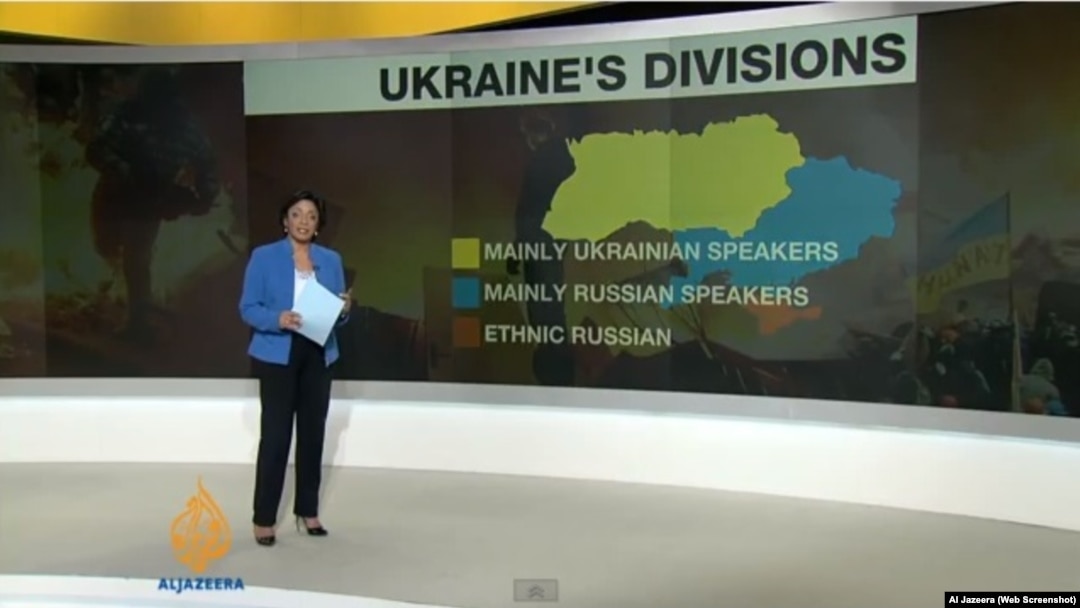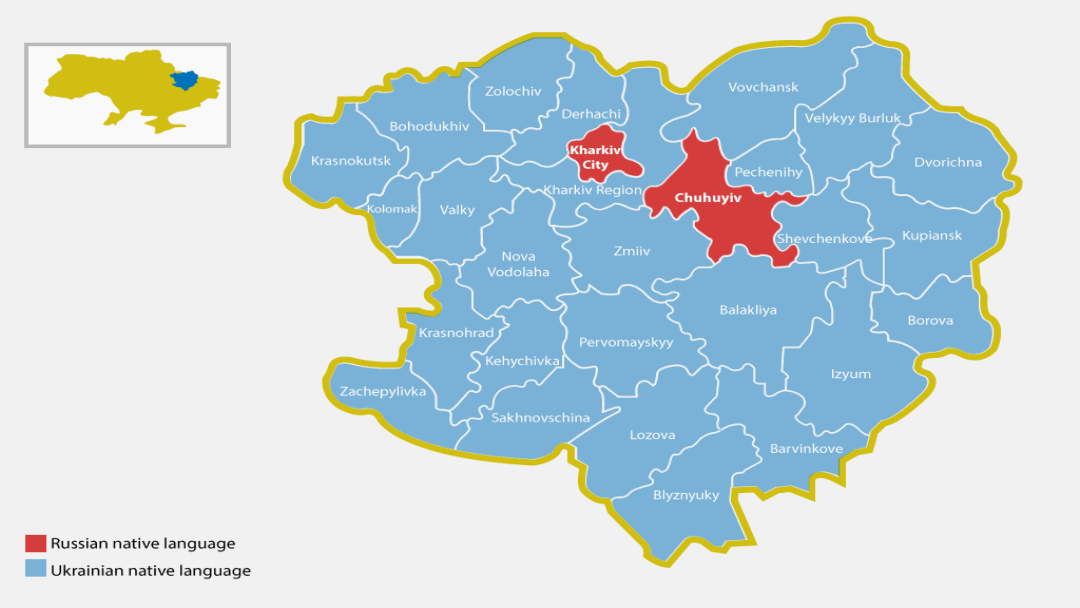The threat seemingly appears during every Ukraine crisis.
In 2004, governors in eastern Ukraine warned that Russia-friendly regions in the east would split if Viktor Yushchenko became president.
The disputed election of Viktor Yanukovych, a Russia-backed candidate, was overturned and Yushchenko won in a revote. The country remained politically divided, but discussion of eastern secession quickly withered.
Ten years later, Yanukovych, elected in 2010 after disappointment in the Orange Revolution, has been ousted, and the east-west divide has again come to the fore.
Iterations of maps like this one, shown on Al-Jazeera on the day Yanukovych fled Kyiv, have told the story thusly.

The eastern part of the country, stretching from Kharkiv Oblast, to the border regions of Donetsk and Luhansk and to the Crimean Peninsula, is seen as predominantly Russian.
Indeed, major cities in the east are largely Russian-speaking industrial hubs and the autonomous Crimean Republic is overwhelmingly Russian-speaking.
A Closer Look
But a closer look within oblasts like Kharkiv shows that maps like the one above may oversimplify the divide.
Kharkiv Oblast includes Kharkiv, Ukraine's second-largest city. Its governor, Mykhaylo Dobkin, recently led a conference of pro-Russian governors that rejected the authority of Ukraine's new government and the region voted strongly for Yanukovych's Party of Regions in the 2010 presidential election.
The city, an industrial center with Soviet-era high-rises and mammoth monuments 50 kilometers from the Russian border, is widely seen -- perhaps next to Donetsk -- as the epitome of Russian Ukraine.
But this is how the region actually looks.
According to 2001 census data, 54 percent of Kharkiv Oblast's nearly 3 million residents identified their native language as Ukrainian, compared to 44 percent -- mostly concentrated in the city -- who said Russian.
Outside the city center, which is one of only two Kharkiv regions that identifies itself as Russophone, the contrast is even starker.
In Donetsk Oblast, further to the east, almost three-quarters of the population identified itself as Russian-speaking, but again, in a majority of regions outside the main city, people were more likely to identify themselves as Ukrainian-speakers.
The Point?
Any effort to break eastern Ukraine from Ukraine proper would meet resistance not only from the western half of the country, but from wide swaths of Ukrainians living within those regions (This is a good time to note that past polls have indicated that a majority of Russian-speakers living in the country have also expressed loyalty to Ukraine and not Russia. Also, some people who identify themselves as Ukrainian-speaking may speak Russian in their day-to-day lives).
"There are significant numbers of ethnic Ukrainians who continue to speak Ukrainian in the east and in the south," says Ukraine scholar Alexander Motyl in a recent interview with RFE/RL. "There are significant numbers of passionate Ukrainians, let's call them patriots, who speak Russian and who prefer Russian culture, and who nevertheless are committed to Ukrainian statehood and Ukrainian nationhood."
In Kharkiv, where the anti-Maidan conference was held on February 22, pro-Maidan supporters have taken over the city-administration building, facing off with protesters who say their loyalty is with Russia.
In Crimea, the home of Russia's Black Sea Fleet and long a hotbed of separatism, thousands of Crimean Tatars -- who made up 11 percent of Crimea's population according to the 2001 census -- have massed in opposition to separation from Ukraine.
Ukraine's diversity runs deep in both its east and west -- ethnolinguistic maps notwithstanding.
In 2004, governors in eastern Ukraine warned that Russia-friendly regions in the east would split if Viktor Yushchenko became president.
The disputed election of Viktor Yanukovych, a Russia-backed candidate, was overturned and Yushchenko won in a revote. The country remained politically divided, but discussion of eastern secession quickly withered.
Ten years later, Yanukovych, elected in 2010 after disappointment in the Orange Revolution, has been ousted, and the east-west divide has again come to the fore.
Iterations of maps like this one, shown on Al-Jazeera on the day Yanukovych fled Kyiv, have told the story thusly.

Al-Jazeera shows a map of Ukraine divided between a largely Ukrainian-speaking west and a predominantly Russian-speaking east.
The eastern part of the country, stretching from Kharkiv Oblast, to the border regions of Donetsk and Luhansk and to the Crimean Peninsula, is seen as predominantly Russian.
Indeed, major cities in the east are largely Russian-speaking industrial hubs and the autonomous Crimean Republic is overwhelmingly Russian-speaking.
A Closer Look
But a closer look within oblasts like Kharkiv shows that maps like the one above may oversimplify the divide.
Kharkiv Oblast includes Kharkiv, Ukraine's second-largest city. Its governor, Mykhaylo Dobkin, recently led a conference of pro-Russian governors that rejected the authority of Ukraine's new government and the region voted strongly for Yanukovych's Party of Regions in the 2010 presidential election.
The city, an industrial center with Soviet-era high-rises and mammoth monuments 50 kilometers from the Russian border, is widely seen -- perhaps next to Donetsk -- as the epitome of Russian Ukraine.
But this is how the region actually looks.
According to 2001 census data, 54 percent of Kharkiv Oblast's nearly 3 million residents identified their native language as Ukrainian, compared to 44 percent -- mostly concentrated in the city -- who said Russian.
Outside the city center, which is one of only two Kharkiv regions that identifies itself as Russophone, the contrast is even starker.
In Donetsk Oblast, further to the east, almost three-quarters of the population identified itself as Russian-speaking, but again, in a majority of regions outside the main city, people were more likely to identify themselves as Ukrainian-speakers.
The Point?
Any effort to break eastern Ukraine from Ukraine proper would meet resistance not only from the western half of the country, but from wide swaths of Ukrainians living within those regions (This is a good time to note that past polls have indicated that a majority of Russian-speakers living in the country have also expressed loyalty to Ukraine and not Russia. Also, some people who identify themselves as Ukrainian-speaking may speak Russian in their day-to-day lives).
"There are significant numbers of ethnic Ukrainians who continue to speak Ukrainian in the east and in the south," says Ukraine scholar Alexander Motyl in a recent interview with RFE/RL. "There are significant numbers of passionate Ukrainians, let's call them patriots, who speak Russian and who prefer Russian culture, and who nevertheless are committed to Ukrainian statehood and Ukrainian nationhood."
In Kharkiv, where the anti-Maidan conference was held on February 22, pro-Maidan supporters have taken over the city-administration building, facing off with protesters who say their loyalty is with Russia.
In Crimea, the home of Russia's Black Sea Fleet and long a hotbed of separatism, thousands of Crimean Tatars -- who made up 11 percent of Crimea's population according to the 2001 census -- have massed in opposition to separation from Ukraine.
Ukraine's diversity runs deep in both its east and west -- ethnolinguistic maps notwithstanding.


